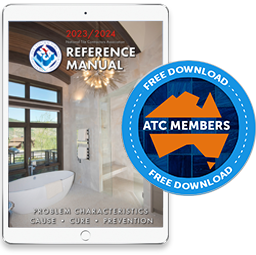Guidelines to achieving a successful tile installation. Double check the following prior to commencement
The correct tiles and quantities have been delivered?
Ensure that all of the tiles which have been delivered are the correct type, and quantity. Errors can occur and it is easier to resolve problems before fixing commences.
Tile suppliers generally may not recognise claims once tiles have been installed.
There are enough tiles to complete the job?
The tile supplier may provide an estimate of the quantities you require.
However the final responsibility rests with the purchaser via their contractor or tradesperson to confirm quantities which should always include allowances for wastage, cutting and spare tiles. If the laying pattern is complex or the tiles are difficult to cut, the percentage allowed for wastage should be increased.
Under measurement may result in a situation where the same tile or batch is not available. If quantities are over-measured, the supplier may levy a handling charge to return excess products or they may simply refuse to accept returns.
The delivered materials are all the same shade (batch) and caliber.
In most instances, tile batches are assigned a shade number and calibre (size). In the event of a shortage, it will be necessary to order the same shade and calibre. The markings are generally printed on the box. It is good advice to keep the marked section from one empty box of each type for later reference.
Shade variation is an inherent feature associated with tile production. It is the tiler’s responsibility to check the markings on all boxes before installation proceeds. If shade numbers are not checked properly, two batches may be installed in the same area. There is always a possibility that neither of these batches would be available if required.
Consequently the cost of remedying this error could be substantial and time consuming.
All shade and calibre markings must be checked prior to commencement.
Tile suppliers will not accept claims after materials have been installed.
Keep copies of all invoices and if possible record shade and calibre numbers.
The Tiler is aware of the exact positioning of any feature, listelli, borders, patterns, trims or accessories.
Ensure that your fixer is conversant with your requirements in regard to the required laying pattern and the precise positioning of any borders or decorative feature tiles, trims or accessories.
He should also be aware of the required width of grout joints, movement joints and perimeter movement joints. The width of grout joints should also be agreed before installation commences, in accordance with ISO or Australian Standards, or tile manufacturers’ written recommendations.
Ensure that defective tiles are not installed.
Instruct your tiler to look for possible defective products, which have small but visible defects. Unfortunately, it is possible that a small number of tiles may be affected. In most instances, these products can be used for cutting.
Defective tiles should not be installed under any circumstances.
Once the tile fixer commences the job he has accepted (on the client’s behalf) the quality of the product. The tile fixer should be instructed (in writing if necessary), to cease work if defective products are discovered and to immediately contact the client who should in turn immediately contact the supplier. Work should not proceed in that particular area until the problem is resolved.
In general terms, suppliers will not recognise claims once tiles have been installed.
During Installation
It is highly recommended that the site be visited regularly to check that:
- The tiles are being installed as instructed.
- Any defective tiles are not being installed.
- Discuss any issues that may have arisen and how they will be resolved.
Tip: To protect yourself against any misunderstanding it is advisable to take dated notes of all discussions and agreements that you have with your tiler.
Post Installation
It is highly recommended that the tiling job is inspected and is acceptable in all aspects before making any final payments.



